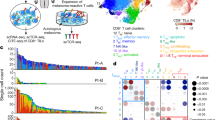Abstract
The recognition by T cells of antigens displayed or presented on the cell surface is generally restricted by the products of genes in the major histocompatibility complex (MHC)1. Thus, most cytotoxic T cells recognize antigens in conjunction with self MHC determinants, especially in the response against virus-infected lymphocytes2, chemically modified self antigens3 and tumour cells4. In these situations, the majority of cytotoxic T-cell clones seems to recognize MHC determinants unique to the individual alleles (‘private’-type determinants). However, certain cell surface antigens seem not to be subject to such rigid MHC restriction5–7. These apparent exceptions could be incorporated into the MHC-restriction model by postulating the involvement of public-type determinants of MHC as restriction site, but until now no cross-killing across species barrier has been reported in these instances. We now report that mouse cytotoxic T cells induced in primary culture by syngeneic melanoma cells killed various human melanoma cell lines in an antigen-specific fashion.
Similar content being viewed by others
References
Zinkernagel, R. M. & Doherty, P. C. Adv. Immun. 27, 52–177 (1979).
Zinkernagel, R. M. & Doherty, P. C. J. exp. Med. 141, 1427–1436 (1975).
Shearer, G. M. Eur. J. Immun. 4, 527–533 (1974).
Shader, J. W. & Edelman, G. M. J. exp. Med. 143, 601–614 (1976).
Lindahl, K. F. Immunogenetics 8, 71–76 (1979).
Molnar-Kimber, K. & Sprent, J. J. exp. Med. 151, 407–417 (1980).
Forma, J. & Flaherty, L. Immunogenetics 6, 227–233.
Burton, R. C., Chism, S. E. & Warner, N. L. J. Immun. 118, 971–980 (1977).
Shaw, S., Nelson, D. L. & Shearer, G. M. J. Immun. 121, 281–289 (1978).
Holden, H. T. & Herberman, R. B. Nature 286, 250–252 (1977).
Shinohara, N., Sachs, D. H., Nonaka, N. & Yzmamoto, H. Nature 292, 362–363 (1981).
Shinohara, N. & Sachs, D. H. J. Immun. 126, 934–937 (1981).
Herlyn, M. et al. Cancer Res. 40, 3602–3609 (1980).
Wilson, B. S., Indiceri, F., Pellegrino, M. A. & Ferrone, S. J. exp. Med. 149, 658–668 (1979).
Author information
Authors and Affiliations
Rights and permissions
About this article
Cite this article
Wakabayashi, S., Taniguchi, M., Tokuhisa, T. et al. Cytotoxic T lymphocytes induced by syngeneic mouse melanoma cells recognize human melanomas. Nature 294, 748–750 (1981). https://doi.org/10.1038/294748a0
Received:
Accepted:
Issue Date:
DOI: https://doi.org/10.1038/294748a0
- Springer Nature Limited





